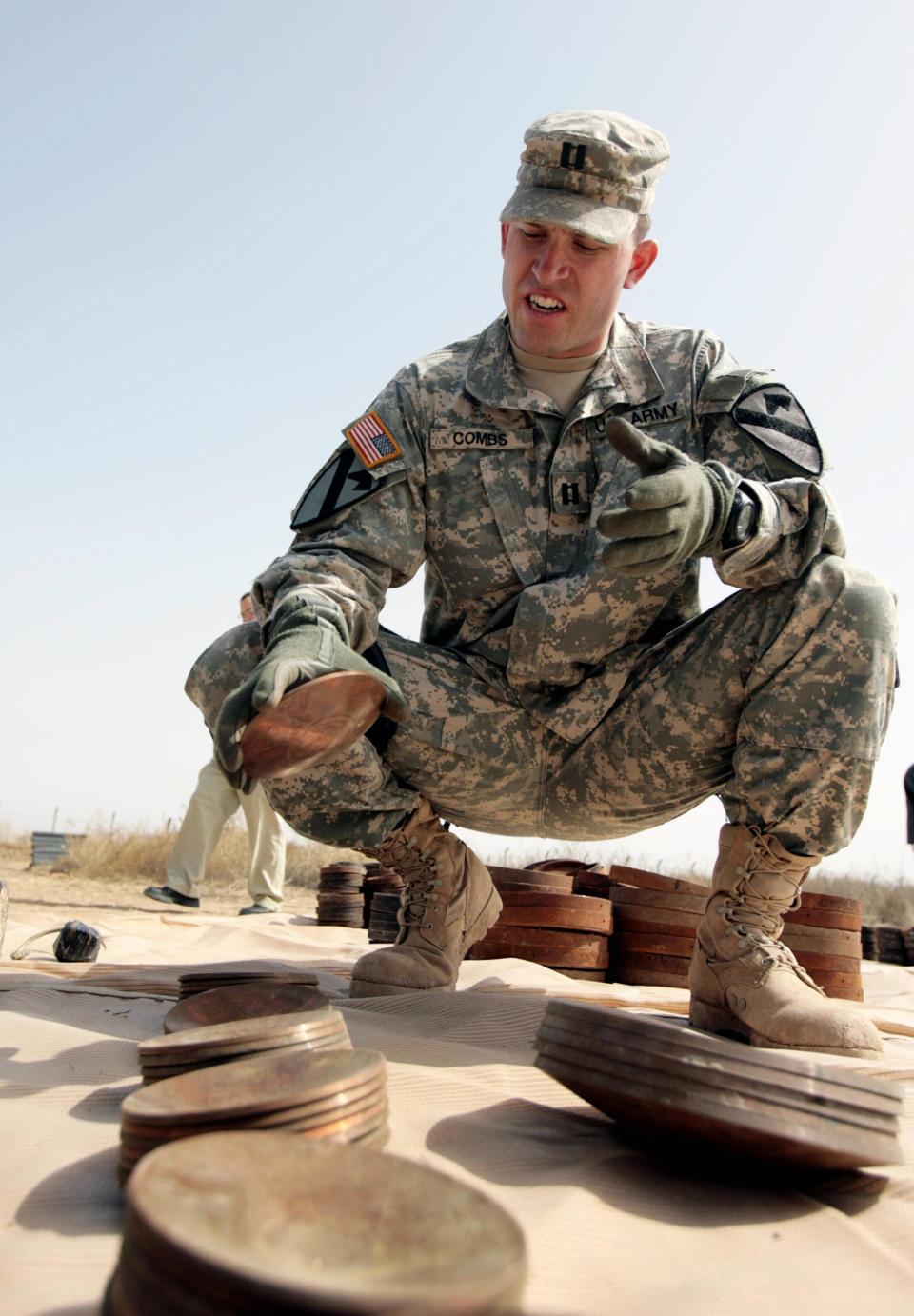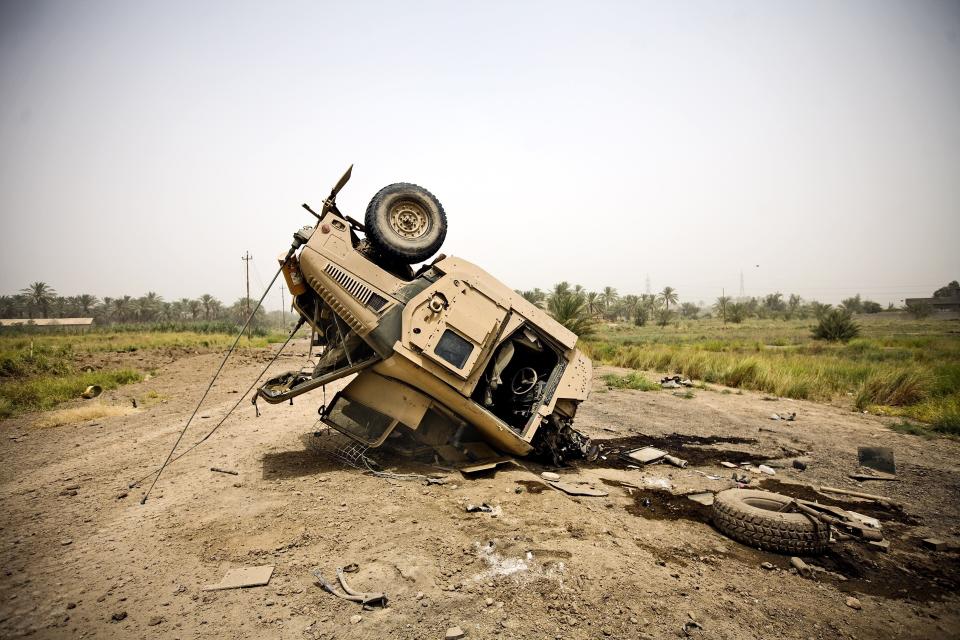Captured Hamas weapons hint that if Israeli forces invade Gaza, they could face a deadly improvised bomb that US troops feared in Iraq
A video released by the IDF shows captured Hamas weapons from the October 7 terrorist attack in Israel.
Explosively formed penetrator IEDs, Iranian-engineered weapons, were spotted in the cache.
EFPs were some of the deadliest explosives US forces faced in Iraq, ripping through troops and armor.
Images of a captured Hamas weapons cache showed a kind of improvised explosive device that terrified US forces in Iraq and could prove a deadly challenge in any Israeli invasion of Gaza,
The Israel Defense Force (IDF) released video footage this week of weapons confiscated from Hamas after the October 7 terror attacks. In the video, which the IDF says shows only a fraction of weapons used in the deadly attacks, a variety of rockets, missiles, mines, and grenades are visible.
—Israel Defense Forces (@IDF) October 16, 2023
Other videos, like one captured by MSNBC and Ynetnews, an Israeli daily news outlet, show even more, including what retired US Army officer and Chair of Urban Warfare Studies at the Modern War Institute John Spencer, has identified as explosively formed penetrator (EFP) improvised explosive devices (IEDs).
"It looks like among the many challenges the @IDF will face in a ground campaign into Gaza is one we feared on a daily basis in Iraq - the Iranian engineering Explosively formed penetrator (EFP) IED," Spencer wrote on X, the social media platform formally known as Twitter.
—John Spencer (@SpencerGuard) October 19, 2023
The explosive is distinct-looking, featuring a concave, shallow disc that rests on a smaller bomb. EFP IEDs are just one type of improvised device, but the weapon gained notoriety for its range, destructive potential, and ability to inflict severe damage on both vehicles and personnel, as it did to US forces during the Iraq War.
The captured cache of Hamas weaponry indicates the group either made its own or acquired them from an external actor, such as Iran. Beyond bringing them into Israel during their bloody assault two weeks ago, it may have a larger stockpile for future use.

EFPs are a specific type of roadside IEDs made of machined copper placed into a variety of cheap, everyday objects, like coffee cans, jars, or kitchen pots. They've seen frequent use by militias, terrorists, and guerilla forces and are typically employed as asymmetric weapons against larger and more formidable targets. Iranian-backed Shiite militias used them during the war in Iraq following the 2003 US invasion.
The late Iranian Gen. Qassem Soleimani, the Islamic Revolutionary Guard Corps Quds Force commander who the US eliminated in a drone strike nearly four years ago, infamously armed Iraqi militias with EFPs and trained them on the Iranian-engineered devices. In a statement on his assassination, the Pentagon blamed him and the Quds Force for the death of American forces.
Once activated, the compact explosives inside the object fire the copper disc upwards, effectively turning it into a hot, high-speed, high-velocity munition. That copper projectile, once heated by explosives, is called a "slug" for its rapid motion out towards the target. While it can deal damage over a few dozen meters, EFPs are far more accurate and destructive at close range or directly beneath a target, like US troops saw in Iraq.
During the US' invasion, troops reported that among the IEDs they faced, the EFPs were far deadlier and more effective than other roadside bombs or explosives they'd encountered. Soldiers said EFPs, hidden in foam blocks imitating street curbs and rocks, ripped through vehicles driving along dirt roads, with shards of the copper slug shredding armor and bodies at incredible speeds. One former Air Force explosive ordnance disposal officer told The Washington Post in 2020 they were the worst explosive device he encountered during his time deployed.
The statistics match the EFPs' deadly reputation, too. The explosives killed at least 196 US troops and wounded nearly 900 between 2005 and 2011, defense officials said in 2015.
Part of the challenge with EFPs, like other IEDs, is how difficult it is to locate or spot them before it is too late, given they may look like ordinary objects. Another challenge is that EFP makers could easily change the bombs' designs to bypass American vehicle countermeasures and ensure the slugs hit their targets.
The American attitude and approach to combat in Iraq likely played a role as well. "We honestly did not believe that these guys were capable of doing this kind of stuff," one senior defense official told The Washington Post in 2007. "We underestimated them."

If these weapons are a part of Hamas' arsenal, it is likely they'd be used in Gaza to fend off an invasion, as urban combat lends itself to tricks and traps. That could be a problem for IDF troops in a ground offensive in the strip.
Spencer noted that Israel likely would not be unprepared for these threats, writing that the IDF "will face this threat and other IEDs with years of their own lessons learned" and countermeasures pulled from past fights, including against Iran-backed Hezbollah in Lebanon.
Since Hamas executed its surprise terror attacks, which killed at least 1,300 people and injured over 4,000 more in Israel, the Israeli military has repeatedly signaled it intends to launch a full-scale invasion of Gaza, a densely packed urban area home to over 2 million people, as its jets bombed the strip.
Israeli airstrikes have destroyed whole areas, killing over 3,000 Palestinians and injuring over 12,000 more, according to the latest United Nations statistics. Israel has said the bombardments are the first step before their ground invasion, effectively softening the target area for for its ground forces.
A devastated urban battlefield is nonetheless difficult, even for the best armies. Israeli forces could still face EFPs hidden in the rubble, complex tunnel networks, or roads. That could spell trouble for IDF troops, of which hundreds of thousands have volunteered or been called up to serve over the past weeks.
Read the original article on Business Insider

